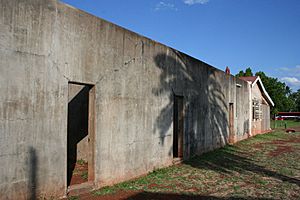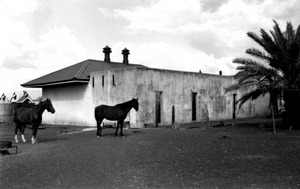Normanton Gaol facts for kids
Quick facts for kids Normanton Gaol |
|
|---|---|

Normanton Gaol, 2010
|
|
| Location | 27 Haigh Street, Normanton, Shire of Carpentaria, Queensland, Australia |
| Design period | 1870s - 1890s (late 19th century) |
| Built | 1892 - 1899 |
| Architect | William Taylor Jack |
| Official name: Normanton Gaol | |
| Type | state heritage (built) |
| Designated | 23 July 1999 |
| Reference no. | 601501 |
| Significant period | 1890s (historical) 1890s (fabric) 1892-1992 (social) |
| Significant components | residential accommodation - trackers' quarters, cell block |
| Builders | Queensland Department of Public Works |
| Lua error in Module:Location_map at line 420: attempt to index field 'wikibase' (a nil value). | |
The Normanton Gaol is an old prison building in Normanton, Queensland, Australia. It's a special place because it shows us what prisons were like a long time ago. The gaol was designed by William Taylor Jack and built between 1892 and 1899. Today, it's listed on the Queensland Heritage Register because of its historical importance.
Contents
A Look Back: History of Normanton Gaol
The Normanton Gaol is actually two main buildings. One is a large cell block made of cement and corrugated iron. The other is a smaller timber building, which was once used by Aboriginal police trackers.
Normanton: A Growing Town
Normanton became a town in 1868. It was an important port, a place where ships could bring goods in and out. It helped connect the Carpentaria region to places like Brisbane. The town was built on a strong ridge, which kept it safe from floods during the wet season.
In 1885, gold was found nearby in Croydon. This made Normanton grow very quickly! A railway line opened in 1891, linking Normanton to Croydon. This made Normanton a busy hub for trade and travel in Queensland's north-west.
Different Cultures in Normanton
Normanton was a mix of many cultures. European settlers came, but also many Chinese immigrants, who were attracted by the goldfields. Aboriginal people also lived in the area. Some were later moved to special reserves.
Why a Gaol in Normanton?
By 1888, Normanton was the main town for the local police and court. A new law in 1890 made a clear difference between a small police lock-up and a larger prison. Normanton first became a police lock-up in 1891.
Plans were made for a bigger gaol. William Taylor Jack, who worked for the government, drew up these plans. He planned for a gaol with 24 cells and a home for the warder (prison guard).
Building the Gaol
The gaol was built on Haigh Street, but it was much smaller than first planned, with only four cells. In 1893, it officially became a full prison. This showed how important Normanton was becoming in the region. The gaol was right in the middle of town, close to the police station and the courthouse. This meant it could be used for both short-term arrests and longer sentences.
The Normanton Gaol was special because it was built with concrete, which was unusual for the time. It even used railway rails inside the walls and ceilings for extra strength. This was a clever idea because the railway had just been built, so rails were available. The concrete also helped stop white ants (termites), which were a big problem for timber buildings. The strong design also made it harder for prisoners to escape.
Gaol Expansion and Staff
As Normanton grew, so did the number of prisoners. The gaol served a huge area, including Croydon, Georgetown, and Cloncurry. By 1895, it was very crowded, with up to 24 prisoners in just four cells!
To fix this, two more cells were added, along with a new kitchen and a fence around the outside. A seventh cell was added in 1899. The head of the prison was usually a police officer from the town.
The Trackers' Quarters
In the corner of the gaol block, there's a small, two-room timber hut. This was the Aboriginal trackers' quarters. Aboriginal trackers were very important to the police. They used their amazing bushcraft skills to help find people who had broken the law, or even lost children. They also helped with other jobs around the police station.
The small size and location of their hut show that their living conditions were very basic, much simpler than the homes for police officers.
The Gaol Closes
The Normanton Gaol stopped being a prison in 1945. After that, it was used by the police as a watch house (a place to hold people temporarily) until late 1992. It closed then because new rules for watch houses meant it was no longer suitable.
What Does Normanton Gaol Look Like?
The Normanton Gaol is a single-story building made of concrete and corrugated iron. It has several doors, each leading to a cell or a group of cells. The smaller trackers' quarters building is behind the main gaol.
The Cell Block
The oldest part of the building, built in 1892, has two large cells and two smaller ones. Each cell has its own exercise yard, enclosed by tall concrete walls (about 3.5 meters high). These yards have strong iron doors with small peep holes and big locks.
Inside the 1892 cells, you can see railway iron rails built into the walls near the ceiling. These helped with air flow and made the building stronger. The ceilings are made of wooden boards.
Later Additions
In 1895, three more cells were added next to the original exercise yard. A fourth cell was added to this section in 1899. Most of these cells are plain, without windows. One cell has louvred windows facing the street. Later, a shower block was added, made of concrete blocks and iron bars.
The Roof
The original part of the gaol has a hipped skillion roof made of galvanised iron. Smaller roofs extend over the exercise yard walls. You can see two fancy finials (decorative tops) on the roof, which also help with ventilation. The newer part of the gaol has a pitched roof with three smaller finials.
The Trackers' Quarters
The trackers' quarters is a simple, single-story building made of weatherboard and corrugated iron. It has two rooms, each with its own door and a window. The roof extends to form a covered porch area, where a toilet and shower are located.
Why Normanton Gaol is Important
The Normanton Gaol is important because it shows us how Queensland's history unfolded, especially in remote areas. It highlights the government's confidence in the growth of mining and farming in the region. It also shows how law and order were established in these growing towns.
It's a rare example of a 19th-century prison that served a distant area. Many other old gaols in Queensland no longer exist. The strong concrete building shows how different a proper prison was from a simple lock-up.
The small trackers' quarters is also important. It helps us understand the role of Aboriginal people in the Queensland Police Service a long time ago.
Finally, the Normanton Gaol has a strong connection to the people of the Gulf region. For many years, it was a place where people who broke the law were held.


